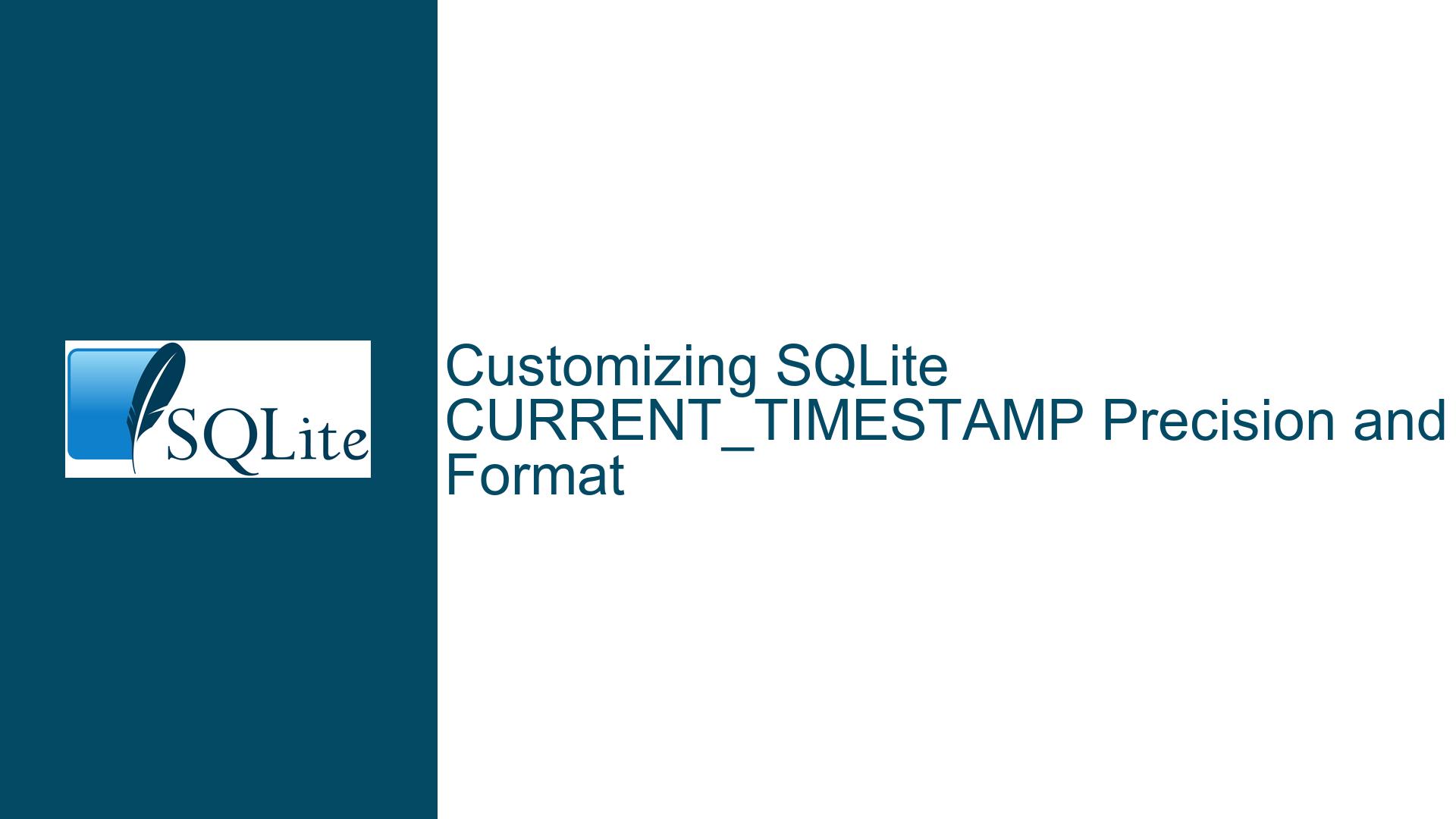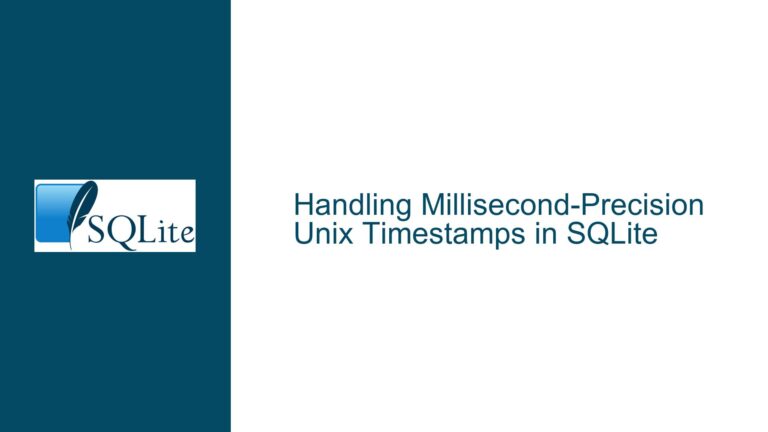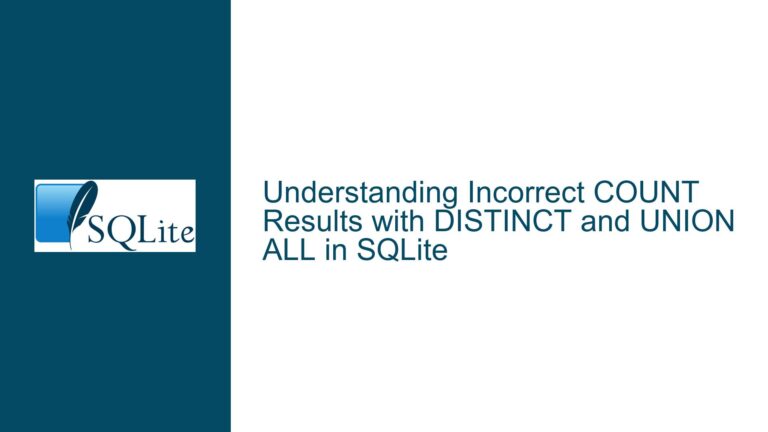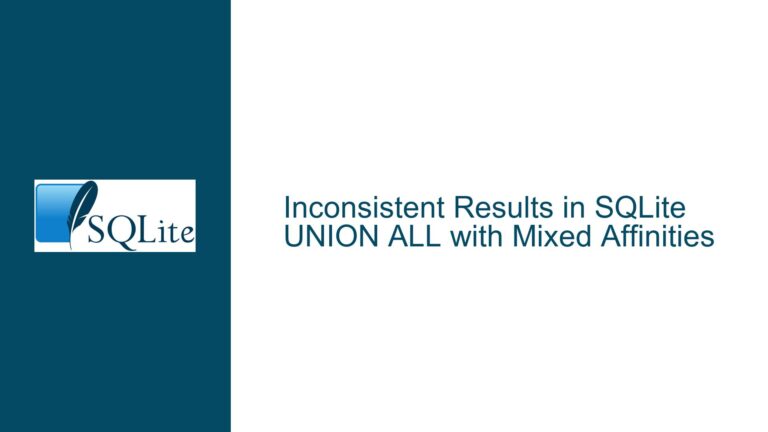Customizing SQLite CURRENT_TIMESTAMP Precision and Format
SQLite CURRENT_TIMESTAMP Default Format and Precision Limitations
The SQLite CURRENT_TIMESTAMP function is a widely used feature for inserting or retrieving the current date and time in SQLite databases. By default, CURRENT_TIMESTAMP returns a string in the format YYYY-MM-DD HH:MM:SS, which lacks sub-second precision and uses a space separator between the date and time components. This default behavior is often sufficient for basic use cases, such as logging events or tracking record modifications. However, for applications requiring higher precision or a specific timestamp format, such as YYYY-MM-DDTHH:MM:SS.SSS, the default implementation falls short.
The CURRENT_TIMESTAMP function in SQLite is designed to provide a simple and consistent way to retrieve the current time, but it does not natively support customization of its output format or precision. This limitation becomes apparent when developers need timestamps with millisecond precision or a specific ISO 8601-compliant format (e.g., YYYY-MM-DDTHH:MM:SS.SSS). While SQLite does offer the strftime function to format dates and times, using strftime as a workaround can feel cumbersome, especially when compared to the simplicity of CURRENT_TIMESTAMP.
The desire for a more flexible CURRENT_TIMESTAMP implementation stems from several practical considerations. First, many modern applications require timestamps with millisecond or microsecond precision to accurately track events or measure performance. Second, standardized timestamp formats, such as ISO 8601, are often required for interoperability with other systems or protocols. Finally, developers often prefer to avoid verbose SQL syntax, such as repeatedly using strftime, when a simpler and more elegant solution exists.
Hardware and System-Level Constraints on Timestamp Precision
The precision and accuracy of timestamps in SQLite are inherently limited by the underlying hardware and system-level timekeeping mechanisms. On most systems, the system clock provides time values with a resolution of seconds or milliseconds, depending on the operating system and hardware capabilities. For example, on a typical desktop or server system, the system clock may have a resolution of 10-15 milliseconds, which means that timestamps with sub-millisecond precision are not meaningful.
Network Time Protocol (NTP) synchronization can improve the accuracy of the system clock, but it does not increase its resolution. Even with NTP, the accuracy of timestamps is limited by network latency, clock drift, and other factors. In practice, this means that timestamps with millisecond precision may not be accurate to the millisecond, especially in environments with high network latency or frequent clock adjustments.
The precision of timestamps also depends on the method used to retrieve the current time. SQLite’s CURRENT_TIMESTAMP function relies on the system clock, which may introduce additional latency or jitter due to process scheduling or other system-level activities. For example, if a process is preempted by the operating system scheduler while retrieving the current time, the resulting timestamp may be delayed by several milliseconds or more.
In addition to hardware and system-level constraints, the format of timestamps can also affect their precision. The default YYYY-MM-DD HH:MM:SS format used by CURRENT_TIMESTAMP does not include sub-second components, which limits its usefulness for high-precision applications. While the strftime function can be used to format timestamps with millisecond or microsecond precision, the resulting values may not reflect the actual resolution of the system clock.
Implementing Custom Timestamp Formats and Precision with strftime and UDFs
To achieve custom timestamp formats and precision in SQLite, developers can use the strftime function or create User-Defined Functions (UDFs). The strftime function provides a flexible way to format dates and times, including support for sub-second precision and custom separators. For example, the following SQL statement uses strftime to generate a timestamp in the YYYY-MM-DDTHH:MM:SS.SSS format:
SELECT strftime('%Y-%m-%dT%H:%M:%f', 'now');
In this example, the %f format specifier is used to include milliseconds in the timestamp. While this approach works, it requires developers to use strftime instead of the simpler CURRENT_TIMESTAMP function, which can make SQL queries more verbose and harder to read.
For developers who prefer a more elegant solution, creating a UDF is a viable alternative. A UDF can encapsulate the logic for generating custom timestamps, allowing developers to use a simple function call instead of strftime. For example, a UDF named custom_timestamp could be defined as follows:
#include <sqlite3.h>
#include <time.h>
#include <stdio.h>
void custom_timestamp(sqlite3_context *context, int argc, sqlite3_value **argv) {
char buffer[24];
time_t now = time(NULL);
struct tm *timeinfo = localtime(&now);
strftime(buffer, sizeof(buffer), "%Y-%m-%dT%H:%M:%S", timeinfo);
snprintf(buffer + 19, sizeof(buffer) - 19, ".%03dZ", (int)((now % 1000) * 1000));
sqlite3_result_text(context, buffer, -1, SQLITE_TRANSIENT);
}
This UDF can be registered with SQLite using the sqlite3_create_function API, allowing it to be used in SQL queries like this:
SELECT custom_timestamp();
While UDFs provide a clean and reusable solution, they have some drawbacks. First, UDFs must be registered with each SQLite connection, which can complicate application code. Second, UDFs are not portable across different SQLite environments, as they require custom code to be compiled and linked with the application. Finally, UDFs may introduce additional overhead compared to built-in functions like CURRENT_TIMESTAMP.
In summary, while SQLite’s CURRENT_TIMESTAMP function provides a simple way to retrieve the current time, its default format and precision may not meet the needs of all applications. Developers can use strftime or UDFs to achieve custom timestamp formats and precision, but these approaches come with trade-offs in terms of complexity and portability. For applications requiring high-precision timestamps or standardized formats, careful consideration of hardware and system-level constraints is essential to ensure meaningful and accurate results.






